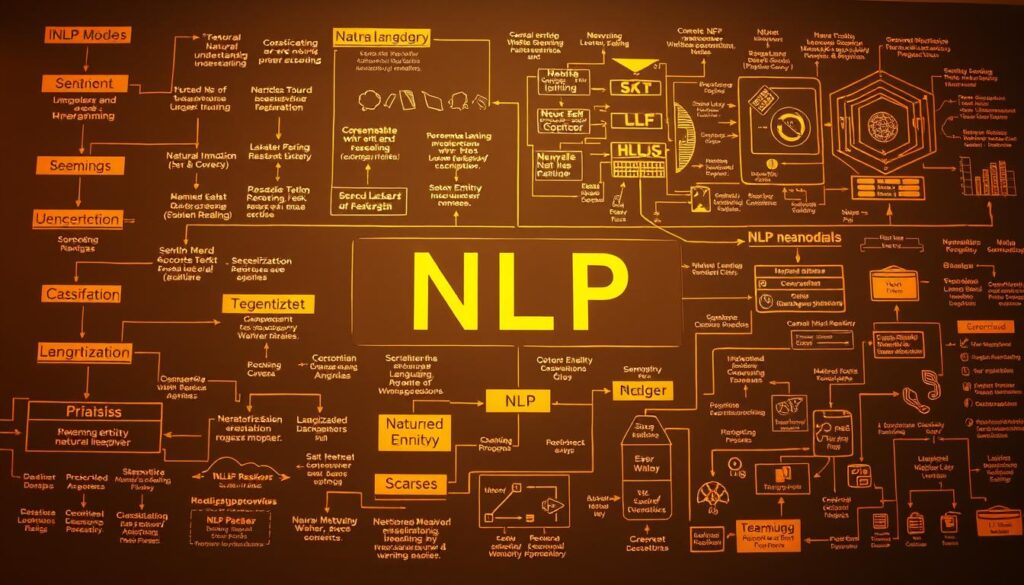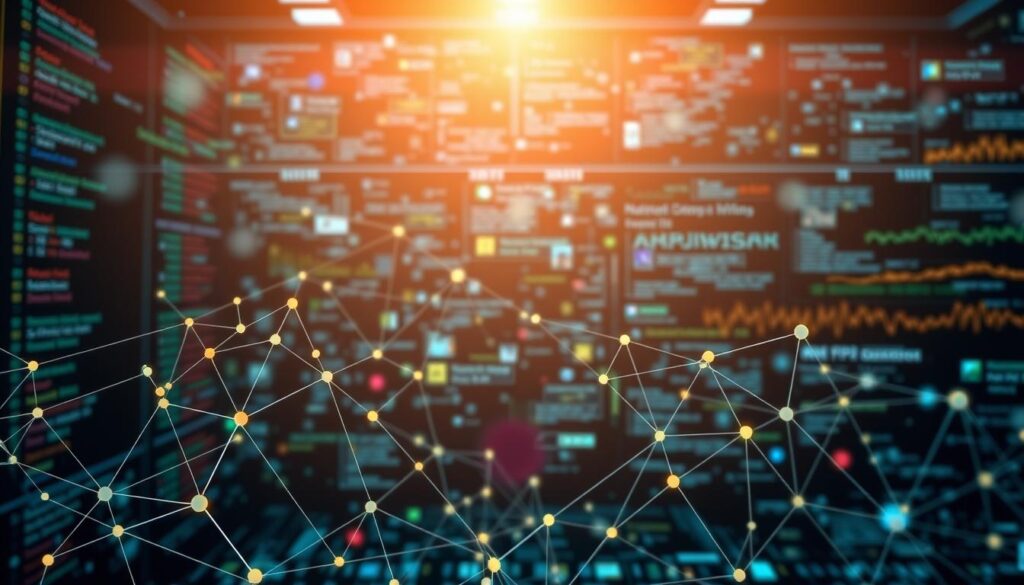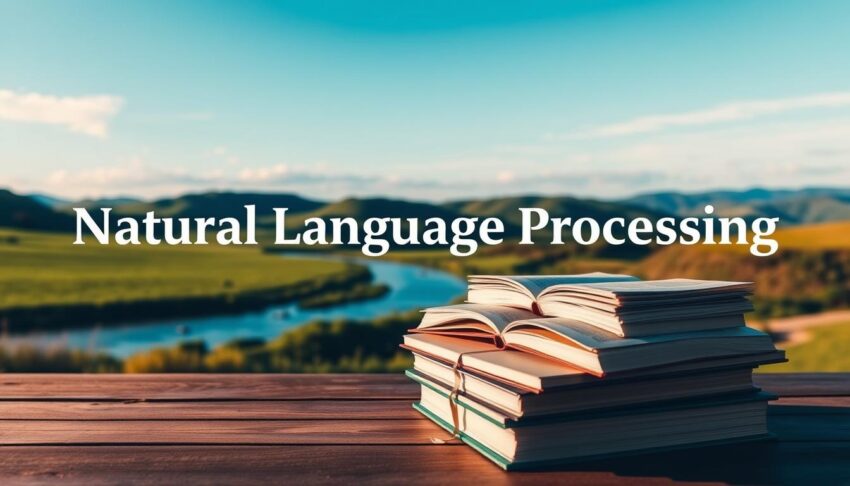Have you ever thought about how machines understand human language so well? Natural Language Processing (NLP) is at the heart of this amazing technology. It mixes artificial intelligence with the details of how we talk.
Thanks to NLP, fields like tech, healthcare, and customer service are changing a lot. This part talks about how NLP lets machines understand and talk back to us. It gives us important insights that help us make better choices and work more efficiently.
Let's explore the basics of NLP and see how it changes the way humans and machines connect.
Key Takeaways
- NLP is a key part of artificial intelligence that deals with human language.
- It helps industries get useful insights from text.
- NLP is making big changes in healthcare and customer service.
- Understanding the subtleties of human language is crucial for machines to learn.
- NLP keeps pushing the boundaries of innovation, helping us make better decisions.
Understanding Natural Language Processing (NLP)
Natural Language Processing is a key part of artificial intelligence. It helps computers talk to humans in their own language. It lets machines understand and answer back in a way we can get.
This tech is great for handling lots of text. It makes talking to machines easier for us.
Definition and Importance
NLP helps computers get what we say. It's used in many things like understanding feelings in text and making chatbots. It's very important for businesses to talk to customers better and work smarter.
How NLP Works
NLP uses special steps to understand language. It breaks down sentences and words into parts. Then, it figures out what it all means.
Machine learning is a big part of NLP. It lets computers learn from lots of text. This way, they get better at understanding us over time.
The Evolution of NLP Technology
NLP technology has grown a lot over time. It has seen big steps forward. These steps have made it better at understanding us.
Historical Background
NLP started in the 1960s. Early programs like ELIZA could talk but didn't really get what we said. This was the start of trying to make machines understand us better.
In the 1980s and 1990s, things got better. Researchers used new ways to make machines smarter. This made them better at understanding words and sounds.
Milestones in NLP Development
There have been many big moments in NLP's growth:
- Machine learning came in the late 1990s. It let machines learn from data, not just rules.
- In the 2010s, neural networks became important. They helped machines understand language better.
- 2017 was a big year. BERT and GPT changed NLP. They helped machines get the meaning behind words.
These steps have made machines better at talking with us. They can understand us in new ways.
NLP Techniques and Algorithms
Natural Language Processing (NLP) uses many techniques and algorithms. These help us understand and analyze human language. They make data processing easier and give us deeper insights from big datasets.
Classification and Clustering
Classification and clustering are key NLP methods. Classification sorts text into groups based on certain traits. For example, an email can be labeled as spam or not.
Clustering groups similar texts without labels. It helps find patterns and user likes. This way, businesses can improve how they connect with people.
Sentiment Analysis
Sentiment analysis looks at opinions and feelings in text. It uses NLP algorithms to see what people think about products or services. This is very useful for social media, where knowing what people feel helps brands.
Good sentiment analysis shows trends. It helps companies answer to what customers say. This way, they can make better choices.
Named Entity Recognition
Named entity recognition (NER) finds and sorts out names, places, and organizations in text. It makes data easier to find and use. This is key for apps that need to understand text well.

Applications of Natural Language Processing (NLP)
NLP is used in many areas, showing its wide use and effect. It helps companies in social media, customer service, and healthcare. These fields get better at talking and making decisions thanks to NLP.
Text Analysis in Social Media
In social media, NLP is key for text analysis. It helps businesses keep up with trends and see what people think. They use smart tools to find important topics and how people feel.
This helps them talk to their audience better and make marketing that people like. It makes their brand more known.
NLP in Customer Service
Customer service has changed a lot with NLP. Chatbots and virtual assistants use NLP to talk to customers fast. They make helping customers easier and better.
They give answers that fit what customers need and cut down wait times. This makes customers happier and more loyal.
Healthcare Applications
Healthcare NLP is very important today. It helps doctors and researchers deal with a lot of data. NLP finds important information that helps with making decisions and caring for patients.
It lets doctors keep up with new research. This helps them give the best treatment for each patient.
Machine Learning and its Role in NLP
Machine learning is key in making natural language processing (NLP) better. Deep learning is a big part of this. It uses unstructured data in a way that's more advanced than before.
Early NLP used traditional machine learning. This method worked with structured data and needed to extract features by hand. Deep learning, on the other hand, can learn from raw data without needing to do this.
Deep Learning vs Traditional Machine Learning
Deep learning has changed NLP a lot. It lets models find patterns in data without needing to be told what to look for. Traditional machine learning had to know what to look for first.
Deep learning models can find important parts of text on their own. This makes them better at tasks like translating languages and figuring out how people feel. Here's how they differ:
| Aspect | Traditional Machine Learning | Deep Learning |
|---|---|---|
| Data Requirements | Needs structured data and a lot of work to prepare | Works with unstructured data and needs less work |
| Complexity of Models | Models are simpler | Uses complex neural networks |
| Performance | Works well but not for very hard tasks | Does great on hard tasks like making text |
Training NLP Models
Training NLP models is a detailed process. First, you need to get the data ready. This means cleaning and organizing the text.
Then, the model is trained. It uses algorithms to learn from the data. Next, you figure out what parts of the data are important. Finally, you check how well the model is doing and make changes as needed.
This careful training makes NLP models very effective. It shows how important machine learning is for NLP.

Popular NLP Tools and Frameworks
NLP is big in many fields now. This has led to many NLP tools and frameworks. They help make text processing better and easier.
Open Source NLP Libraries
Many developers love open-source libraries. They are good because they are flexible and have lots of help from the community. NLTK, SpaCy, and Hugging Face's Transformers are top picks.
These libraries make working with text data easy. They have simple interfaces and lots of help. NLTK is great for text work. SpaCy is fast and efficient. Hugging Face's Transformers is known for its advanced NLP models.
Cloud-Based NLP Solutions
Cloud-based NLP solutions are great for those who want strong tools without a lot of setup. IBM Watson and Google Cloud Natural Language are good examples. They offer APIs that make it easy to add NLP to apps.
These cloud solutions have cool features like finding feelings in text and recognizing names. They help businesses make their text work better without the hassle of setting up their own systems.
The Future of Natural Language Processing (NLP)
The future of NLP looks bright. New trends are changing how we understand and talk to each other. These changes will bring more advanced uses in many areas. It's important for everyone to know about these trends and the ethics behind them.
Trends to Watch
Conversational AI is becoming more important. It makes talking to machines feel natural. Companies are using chatbots and virtual assistants more and more.
Another big trend is understanding many languages. This lets NLP systems talk to people in different languages. It makes things more accessible and friendly for everyone worldwide.
Ethical Considerations in NLP
As NLP becomes part of our daily lives, ethics matter more. Using data raises questions about privacy and consent. There's also the issue of bias in language models.
It's important to be open and fair. We need strong ethics in making and using NLP. This builds trust and makes sure things are done right.
Challenges in Implementing NLP Solutions
More companies are using NLP for better data analysis and understanding customers. But, they face many challenges. These include data privacy and understanding different languages and cultures.
Data Privacy Concerns
Data privacy is a big issue with NLP. Laws like GDPR say data must be handled carefully. Companies must protect personal data well to avoid big problems.
Language and Cultural Nuances
Language is complex and can cause problems with NLP. Different words and ways of speaking can lead to mistakes. To make NLP work well, we need to study these differences.
| Challenge | Description | Impact |
|---|---|---|
| Data Privacy | Compliance with regulations like GDPR | Potential legal and financial repercussions |
| Language Nuances | Diverse dialects and cultural references | Risk of misinterpretation and user dissatisfaction |
Conclusion
Natural Language Processing (NLP) is changing the game. It's not just a new tool; it's a key player in making industries better. NLP helps in healthcare, customer service, and social media, making decisions easier and finding new ways to solve problems.
The future of NLP looks bright. More companies will use it to understand lots of text. This will help them talk to machines in new ways.
Looking at NLP, we see its wide range of uses. It has a rich history and raises important questions about ethics. But, using NLP right is key. We must think about privacy and cultural differences.
In the end, NLP is changing how we talk to machines. As more businesses use it, we'll see big changes. NLP will make our communication and analysis better, leading to exciting times ahead.
